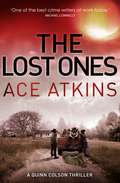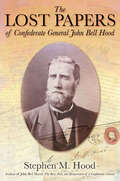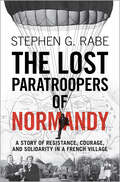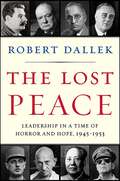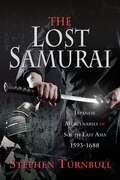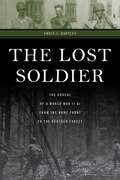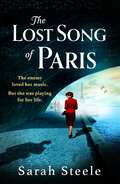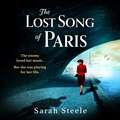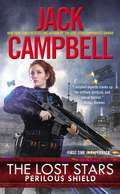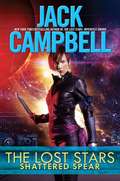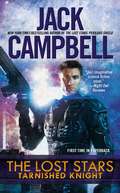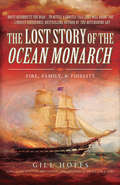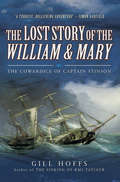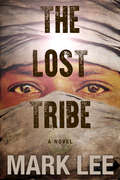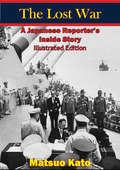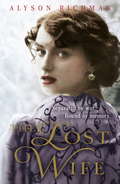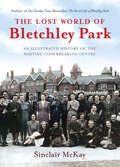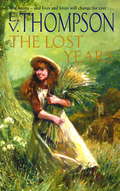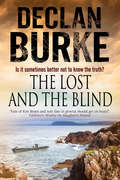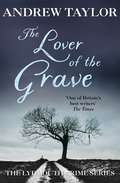- Table View
- List View
The Lost Ones (Quinn Colson #2)
by Ace AtkinsWhen Army Ranger Quinn Colson, the new sheriff of Tebbehah County, is called out to investigate a child abuse case, what he finds is a horrifying scene of neglect, thirteen empty cribs, and a shoe box full of money. Janet and Ramon Torres seem to have skipped town - but Colson's sure they'll come back for the cash. Meanwhile, Colson's sister has returned - clean and sober for good she says. His friend Boom has been drinking himself into oblivion and picking fights at the local bar. And his old flame is pregnant. But Colson can't focus on his personal problems. He and Deputy Lillie Virgil are convinced that Janet and Ramon have a taste for guns, drugs, and human trafficking. Soon Colson and Virgil find a link between the fugitive couple and a drug cartel that controls most of the Texas border, taking their investigation far beyond the rough hills of northeast Mississippi...
The Lost Papers of Confederate General John Bell Hood
by Stephen M. HoodScholars hail the find as “the most important discovery in Civil War scholarship in the last half century.” The invaluable cache of Confederate General John Bell Hood’s personal papers includes wartime and postwar letters from comrades, subordinates, former enemies and friends, exhaustive medical reports relating to Hood’s two major wounds, and dozens of touching letters exchanged between Hood and his wife, Anna. This treasure trove of information is being made available for the first time for both professional and amateur Civil War historians in Stephen “Sam” Hood’s The Lost Papers of Confederate General John Bell Hood. The historical community long believed General Hood’s papers were lost or destroyed, and numerous books and articles were written about him without the benefit of these invaluable documents. In fact, the papers were carefully held for generations by a succession of Hood’s descendants, and in the autumn of 2012 transcribed by collateral descendent Sam Hood as part of his research for his book John Bell Hood: The Rise, Fall, and Resurrection of a Confederate General (Savas Beatie, 2013.) This collection offers more than 200 documents. While each is a valuable piece of history, some shed important light on some of the war’s lingering mysteries and controversies. For example, several letters from multiple Confederate officers may finally explain the Confederate failure to capture or destroy Schofield’s Union army at Spring Hill, Tennessee, on the night of November 29, 1864. Another letter by Lt. Gen. Stephen D. Lee goes a long way toward explaining Confederate Maj. Gen. Patrick Cleburne’s gallant but reckless conduct that resulted in his death at Franklin. Lee also lodges serious allegations against Confederate Maj. Gen. William Bate. While these and others offer a military perspective of Hood the general, the revealing letters between he and his beloved and devoted wife, Anna, help us better understand Hood the man and husband. Historians and other writers have spent generations speculating about Hood’s motives, beliefs, and objectives, and the result has not always been flattering or even fully honest. Now, long-believed “lost” firsthand accounts previously unavailable offer insights into the character, personality, and military operations of John Bell Hood the general, husband, and father.
The Lost Paratroopers of Normandy: A Story of Resistance, Courage, and Solidarity in a French Village
by Stephen G. RabeThe fateful days and weeks surrounding 6 June 1944 have been extensively documented in histories of the Second World War, but less attention has been paid to the tremendous impact of these events on the populations nearby. The Lost Paratroopers of Normandy tells the inspiring yet heartbreaking story of ordinary people who did extraordinary things in defense of liberty and freedom. On D-Day, when transport planes dropped paratroopers from the 82nd and 101st Airborne Divisions hopelessly off-target into marshy waters in northwestern France, the 900 villagers of Graignes welcomed them with open arms. These villagers – predominantly women – provided food, gathered intelligence, and navigated the floods to retrieve the paratroopers'paratroopers' equipment at great risk to themselves. When the attack by German forces on 11 June forced the overwhelmed paratroopers to withdraw, many made it to safety thanks to the help and resistance of the villagers. In this moving book, historian Stephen G. Rabe, son of one of the paratroopers, meticulously documents the forgotten lives of those who participated in this integral part of D-Day history.
The Lost Peace: Leadership in a Time of Horror and Hope, 1945–1953
by Robert Dallek"Robert Dallek brings to this majestic work a profound understanding of history, a deep engagement in foreign policy, and a lifetime of studying leadership. The story of what went wrong during the postwar period…has never been more intelligently explored." —Doris Kearns Goodwin, author of the Pulitzer Prize-winning Team of RivalsRobert Dalleck follows his bestselling Nixon and Kissenger: Partners in Power and An Unfinished Life: John F. Kennedy, 1917-1963 with this masterful account of the crucial period that shaped the postwar world. As the Obama Administration struggles to define its strategy for the wars in Afghanistan and Iraq, Dallek's critical and compelling look at Truman, Churchill, Stalin, and other world leaders in the wake of World War II not only offers important historical perspective but provides timely insight on America's course into the future.
The Lost Samurai: Japanese Mercenaries in South East Asia, 1593–1688
by Stephen Turnbull“An inherently fascinating, impressively well written, exceptionally informative, and meticulously detailed history” of Japanese overseas mercenaries (Midwest Book Review).The Lost Samurai reveals the greatest untold story of Japan’s legendary warrior class, which is that for almost a hundred years Japanese samurai were employed as mercenaries in the service of the kings of Siam, Cambodia, Burma, Spain and Portugal, as well as by the directors of the Dutch East India Company.The Japanese samurai were used in dramatic assault parties, as royal bodyguards, as staunch garrisons and as willing executioners. As a result, a stereotypical image of the fierce Japanese warrior developed that had a profound influence on the way they were regarded by their employers.While the Southeast Asian kings tended to employ samurai on a long-term basis as palace guards, their European employers usually hired them on a temporary basis for specific campaigns. Also, whereas the Southeast Asian monarchs tended to trust their well-established units of Japanese mercenaries, the Europeans, while admiring them, also feared them. In every European example a progressive shift in attitude may be discerned from initial enthusiasm to great suspicion that the Japanese might one day turn against them, as illustrated by the long-standing Spanish fear of an invasion of the Philippines by Japan accompanied by a local uprising.During the 1630s, when Japan chose isolation rather than engagement with Southeast Asia, it left these fierce mercenaries stranded in distant countries never to return: lost samurai indeed!
The Lost Shtetl: A Novel
by Max GrossWINNER OF THE NATIONAL JEWISH BOOK AWARD AND THE JEWISH FICTION AWARD FROM THE ASSOCIATION OF JEWISH LIBRARIESGOOD MORNING AMERICA MUST READ NEW BOOKS * NEW YORK POST BUZZ BOOKS * THE MILLIONS MOST ANTICIPATEDA remarkable debut novel—written with the fearless imagination of Michael Chabon and the piercing humor of Gary Shteyngart—about a small Jewish village in the Polish forest that is so secluded no one knows it exists . . . until now.What if there was a town that history missed?For decades, the tiny Jewish shtetl of Kreskol existed in happy isolation, virtually untouched and unchanged. Spared by the Holocaust and the Cold War, its residents enjoyed remarkable peace. It missed out on cars, and electricity, and the internet, and indoor plumbing. But when a marriage dispute spins out of control, the whole town comes crashing into the twenty-first century.Pesha Lindauer, who has just suffered an ugly, acrimonious divorce, suddenly disappears. A day later, her husband goes after her, setting off a panic among the town elders. They send a woefully unprepared outcast named Yankel Lewinkopf out into the wider world to alert the Polish authorities. Venturing beyond the remote safety of Kreskol, Yankel is confronted by the beauty and the ravages of the modern-day outside world – and his reception is met with a confusing mix of disbelief, condescension, and unexpected kindness. When the truth eventually surfaces, his story and the existence of Kreskol make headlines nationwide. Returning Yankel to Kreskol, the Polish government plans to reintegrate the town that time forgot. Yet in doing so, the devious origins of its disappearance come to the light. And what has become of the mystery of Pesha and her former husband? Divided between those embracing change and those clinging to its old world ways, the people of Kreskol will have to find a way to come together . . . or risk their village disappearing for good.
The Lost Soldier: The Ordeal of a World War II G.I. from the Home Front to the Hürtgen Forest
by Chris J. HartleyThe Lost Soldier offers a perspective on World War II we don&’t always get from histories and memoirs. Based on the letters home of Pete Lynn, the diary of his wife, Ruth, and meticulous research in primary and secondary sources, this book recounts the war of a married couple who represent so many married couples, so many soldiers, in World War II. The book tells the story of this couple, starting with their life in North Carolina and recounting how the war increasingly insinuated itself into the fabric of their lives, until Pete Lynn was drafted, after which the war became the essential fact of their life. Author Chris J. Hartley intricately weaves together all threads—soldier and wife, home front and army life, combat, love and loss, individual and army division—into an intimate, engaging narrative that is at once gripping military history and engaging social history.
The Lost Song of Paris: Heartwrenching WW2 historical fiction with an utterly gripping story inspired by true events
by Sarah Steele'A fantastic read. I was gripped and enthralled. Wonderful storytelling' JILL MANSELL'Fascinating, moving, romantic and utterly gripping. I couldn't stop reading' KATIE FFORDE'Readers will adore walking through occupied Paris in the footsteps of the brave. A fabulous story' MANDY ROBOTHAM'A tense, heart-in-mouth story about courage in Occupied Paris, and secrets' GILL PAULInspired by true events, a heartwrenching story of lost love, danger and one woman's bravery in WWII, perfect for fans of My Name is Eva, The Shut Away Sisters and The Secret Messenger. _________'For a moment she closed her eyes and imagined she was perched on the diving board at the Piscine Molitor, the sun beating down on her bare shoulders and the sound of Parisians at play beneath her. All she had to do was jump.'1941. Darkness descends over London as the sirens begin to howl and the bombs rain down. Devastation seeps from every crack of the city. In the midst of all the chaos is a woman gripping a window ledge on the first floor of a Baker Street hotel. She is perched, ready to jump. And as flames rise around her, she is forced to take her chances. 1997. Amy Novak has lost the two great loves in her life: her husband, Michael, and her first love, music. With the first anniversary of Michael's death approaching, Amy buries herself in her job as an archivist. And when a newly declassified file lands on her desk, she is astonished to uncover proof that 'Agent Colette' existed - a name spoken only in whispers; an identity so secret that it has never been verified. Her discovery leads her to MI6 'godmother' Verity Cooper - a woman with secrets of her own - and on to the streets of Paris where she will uncover a story of unimaginable choices, extraordinary courage and a love that will defy even the darkest days of World War Two . . ._________What real readers are saying about The Lost Song of Paris:'I loved this book - a perfect summer read' ⭐ ⭐ ⭐ ⭐ ⭐'Truly riveting... A heartwrenching story of love and the bravery and danger of those involved in espionage. A must-read in historical fiction' ⭐ ⭐ ⭐ ⭐ ⭐'A heartwrenching story. LOVE IT, LOVE IT, LOVE IT, LOVE IT, LOVE IT!!!!!! THIS BOOK MUST BE READ!!' ⭐ ⭐ ⭐ ⭐YOUR FAVOURITE AUTHORS ADORE THE LOST SONG OF PARIS:'The Lost Song of Paris takes you right into the beating heart of occupied France [and] shows us the best and worst of what it is to be human, and the redeeming power of love . . . heart-wrenching' Jane Bailey'Sarah writes with a lyrical beauty. This is a novel you should not miss and is impossible to put down' Caroline MontagueFIND OUT WHY READERS LOVE SARAH STEELE:'A beautifully worked tale of bravery, woven into the reality of a time we can't forget'Mandy Robotham 'An emotional, beautifully constructed read. I loved the way the clues from the past and present slowly knitted together, answering the questions that had been missing their answers for so long'Jill Mansell 'Gripping, at times heartbreaking, but ultimately uplifting, I found this beautifully written novel impossible to put down' Katie Fforde'A triumph!'Gill Paul 'Evocative writing and the storytelling is masterful. It really draws the reader in'Felicity Hayes-McCoy 'A gripping journey about the quiet triumphs and breathtaking courage of so many women in wartime'Jane Bailey
The Lost Song of Paris: Heartwrenching WW2 historical fiction with an utterly gripping story inspired by true events
by Sarah Steele'A fantastic read. I was gripped and enthralled. Wonderful storytelling' JILL MANSELL'Fascinating, moving, romantic and utterly gripping. I couldn't stop reading' KATIE FFORDE'Readers will adore walking through occupied Paris in the footsteps of the brave. A fabulous story' MANDY ROBOTHAM'A tense, heart-in-mouth story about courage in Occupied Paris, and secrets' GILL PAULInspired by true events, a heartwrenching story of lost love, danger and one woman's bravery in WWII, perfect for fans of My Name is Eva, The Shut Away Sisters and The Secret Messenger. _________'For a moment she closed her eyes and imagined she was perched on the diving board at the Piscine Molitor, the sun beating down on her bare shoulders and the sound of Parisians at play beneath her. All she had to do was jump.'1941. Darkness descends over London as the sirens begin to howl and the bombs rain down. Devastation seeps from every crack of the city. In the midst of all the chaos is a woman gripping a window ledge on the first floor of a Baker Street hotel. She is perched, ready to jump. And as flames rise around her, she is forced to take her chances. 1997. Amy Novak has lost the two great loves in her life: her husband, Michael, and her first love, music. With the first anniversary of Michael's death approaching, Amy buries herself in her job as an archivist. And when a newly declassified file lands on her desk, she is astonished to uncover proof that 'Agent Colette' existed - a name spoken only in whispers; an identity so secret that it has never been verified. Her discovery leads her to MI6 'godmother' Verity Cooper - a woman with secrets of her own - and on to the streets of Paris where she will uncover a story of unimaginable choices, extraordinary courage and a love that will defy even the darkest days of World War Two . . ._________What real readers are saying about The Lost Song of Paris:'I loved this book - a perfect summer read' ⭐ ⭐ ⭐ ⭐ ⭐'Truly riveting... A heartwrenching story of love and the bravery and danger of those involved in espionage. A must-read in historical fiction' ⭐ ⭐ ⭐ ⭐ ⭐'A heartwrenching story. LOVE IT, LOVE IT, LOVE IT, LOVE IT, LOVE IT!!!!!! THIS BOOK MUST BE READ!!' ⭐ ⭐ ⭐ ⭐YOUR FAVOURITE AUTHORS ADORE THE LOST SONG OF PARIS:'The Lost Song of Paris takes you right into the beating heart of occupied France [and] shows us the best and worst of what it is to be human, and the redeeming power of love . . . heart-wrenching' Jane Bailey'Sarah writes with a lyrical beauty. This is a novel you should not miss and is impossible to put down' Caroline MontagueFIND OUT WHY READERS LOVE SARAH STEELE:'A beautifully worked tale of bravery, woven into the reality of a time we can't forget'Mandy Robotham 'An emotional, beautifully constructed read. I loved the way the clues from the past and present slowly knitted together, answering the questions that had been missing their answers for so long'Jill Mansell 'Gripping, at times heartbreaking, but ultimately uplifting, I found this beautifully written novel impossible to put down' Katie Fforde'A triumph!'Gill Paul 'Evocative writing and the storytelling is masterful. It really draws the reader in'Felicity Hayes-McCoy 'A gripping journey about the quiet triumphs and breathtaking courage of so many women in wartime'Jane Bailey
The Lost Song of Paris: Heartwrenching WW2 historical fiction with an utterly gripping story inspired by true events
by Sarah SteeleShe played for love. She fought for freedom.Inspired by incredible true events, The Lost Song of Paris is a heart-wrenching story of lost love, danger and espionage and one remarkable woman's bravery in World War Two, from the bestselling author of The Missing Pieces of Nancy Moon and The Schoolteacher of Saint-Michel. This unforgettable novel is perfect for fans of My Name is Eva, The Shut Away Sisters and The Secret Messenger. _________'For a moment she closed her eyes and imagined she was perched on the diving board at the Piscine Molitor, the sun beating down on her bare shoulders and the sound of Parisians at play beneath her. All she had to do was jump.'1941. Darkness descends over London as the sirens begin to howl and the bombs rain down. Devastation seeps from every crack of the city. In the midst of all the chaos is a woman gripping a window ledge on the first floor of a Baker Street hotel. She is perched, ready to jump. And as flames rise around her, she is forced to take her chances. 1997. Amy Novak has lost the two great loves in her life: her husband, Michael, and her first love, music. With the first anniversary of Michael's death approaching, Amy buries herself in her job as an archivist. And when a newly declassified file lands on her desk, she is astonished to uncover proof that Agent 'Colette' existed - a name spoken only in whispers; an identity so secret that it has never been verified. Her discovery leads her to MI6 'godmother' Verity Cooper - a woman with secrets of her own - and on to the streets of Paris where she will uncover a story of unimaginable choices, extraordinary courage and a love that will defy even the darkest days of World War Two . . .(P) 2022 Headline Publishing Group Ltd
The Lost Stars: Perilous Shield
by Jack CampbellFollowing a successful coup against the tyrannical Syndicate, the leaders of the rebel Midway Star System work to forge a government free enough to please its citizens yet strong enough to secure power. <P><P>But in a world where former rulers have become new foes, an alien threat to humanity may turn old adversaries into uncertain allies. <P> President Gwen Iceni believes Midway is their only defense against the enigmas. Syndicate training taught her self-preservation in a crisis, yet she's determined to fight for the star system's fate...even if it means joining forces with another former Syndicate CEO--and an officer of the hated Alliance. <P>Despite General Artur Drakon's misgivings, he partnered with Iceni to overthrow Syndic forces. Now, with an enigma fleet menacing their hard-earned independence, he can ill afford to trust her--or lose her support. But in the back of his mind, there are three words that describe someone who confides in a Syndicate CEO: Stupid. Betrayed. Dead. nigmas. Syndicate training taught her self-preservation in a crisis, yet she's determined to fight for the star system's fate...even if it means joining forces with Drakon--and an officer of the hated Alliance. <P> Their plan places the Midway flotilla at great risk in hopes of greater reward: recruiting the personnel necessary to man warships against the enigmas. But before facing the alien advance, Drakon and Iceni must survive hidden dangers closer to home: all-too-human threats that could jeopardize Midway's freedom...and their own lives.
The Lost Stars: Shattered Spear
by Jack CampbellThe New York Times bestselling author of The Lost Fleet returns to the “strong saga”* of a rebellion against a totalitarian regime and the determination of two people to create a better future in the farthest reaches of the colonized galaxy... The Syndicate Worlds continue to splinter as more star systems pledge allegiance to President Gwen Iceni, General Artur Drakon, and the new government they’re establishing at Midway. But the toxic legacy of Syndicate rule continues to undermine their efforts as the rebels encounter difficulty trusting one another and believing their new leaders’ promises of freedom from tyranny. Before Iceni and Drakon can put their house in order, they must deal with an even greater threat. An enigma warship has appeared and vanished near a Syndic colony. If the aliens are capable of jumping into other human-occupied star systems, then billions of people could be vulnerable to a hostile invasion fleet anywhere they choose to strike. But an even greater vulnerability lies with Iceni and Drakon, as a once-trusted adviser-turned-saboteur plans revenge...
The Lost Stars: Tarnished Knight
by Jack CampbellCEO Artur Drakon has been betrayed. The Syndicate Worlds' government failed to protect its citizens from both the Alliance and the alien enigmas. With a cadre of reliable soldiers under his command, Drakon launches a battle for control of the Midway Star System-assisted by an ally he's unsure he can trust... CEO Gwen Iceni was exiled to Midway because she wasn't ruthless enough in the eyes of her superiors. She proved them wrong by commandeering some of the warships at Midway and declaring the star system's independence on behalf of the people though staying in charge as "President. " But while she controls the mobile fleet, she has no choice but to rely on "General" Drakon's ground forces to keep the peace planet-side. If their coup is to succeed, Drakon and Iceni must put their differences aside to prevent the population of Midway from rebelling against them, to defend their star system from the enigmas-and to ferret out saboteurs determined to reestablish Syndic rule... .
The Lost Story of the Ocean Monarch: Fire, Family, & Fidelity
by Gill HoffsThe ship was almost instantly in flames Some jumped overboard immediately, and all was in indescribable confusion. The masts began to fall one after another, and it is supposed killed great numbers by their descent. Others, it is feared, were roasted alive, but the majority were drowned. (Hull Advertiser and Exchange Gazette, 25 August 1848)The Ocean Monarch was only a few hours out of Liverpool on 24 August 1848 when a cabin passenger shouted Fire! and all hell broke loose. Bound for Boston with almost 400 people on board, the emigrant ship was soon ablaze with little chance of putting the flames out. People watched helplessly from their cottages along the Welsh coast as some ships ignored the travellers plight while others raced to their aid. On the 170th anniversary of the disaster Gill Hoffs reveals the full story of this forgotten wreck, including tales of French royalty, an American artist, and a courageous stewardess who gave her life to save her fellow travellers. Discover what happened to the passengers and crew, including:James K. Fellows, a kindly American jeweller trying to get home to his familyJotham Bragdon, the first mate who fled the wreck then returned to shore a heroMary Walter and her mysterious family, escaping danger in London only to find greater peril lay at seaFollow the murder trial of a crew of rescuers and find out the real fate of their victim and whether the mysterious Irish toddler Kate found her family again.
The Lost Story of the William and Mary: The Cowardice of Captain Stinson
by Gill HoffsThe emigrant ship William and Mary departed from Liverpool with 208 British, Irish, and Dutch emigrants in early 1853. Captained by young American Timothy Stinson, the vessel was sailing for New Orleans when the ship wrecked in the Bahamas in mysterious circumstances. Instead of grounding the ship on a nearby shore or building rafts for the passengers, Stinson and the majority of his crew sneaked away in lifeboats murdering at least two of the emigrants with a hatchet as they did so and reported the ship sunk with all on board lost. But the passengers kept the ship afloat and two days later were rescued by heroic wreckers as the ship went down. Now, over 160 years on, the tale of the two murdered in Bahamian waters and the hundreds who escaped thanks to kindly wreckers can finally be told. Stinson is no longer getting away with murder.
The Lost Tribe
by Mark LeeThis powerful first novel tells the story of David Mather, a charismatic relief worker who believes that a mysterious group of African nomads are the descendants of the legendary Lost Tribes of Israel. Mather organizes An expedition to find the tribe; it includes an anthropologist, an African shaman; and Ben Chase, the young journalist who is the book's narrator. Traveling north through a chaotic, war-torn country, these modern pilgrims encounter soldiers and guerrillas, a deranged family or neo-colonials, and a city ravaged by an unexplained plague. As they search for the elusive veiled tribe, Chase must deal with Mather's apocalyptic vision and his own changing perception of this dangerous world. Written with the pace of an adventure tale, The Lost Tribe is a complex exploration of the uncertain borderland between faith and despair.
The Lost War: A Japanese Reporter’s Inside Story [Illustrated Edition]
by Masuo KatoIncludes The Bombing Of Japan During World War II illustrations pack with 120 maps, plans, and photos"Masuo Kato, an American educated Japanese newspaper man, represented the Domei news agency in Washington from 1937 to 1941, was repatriated in the first exchange. and served thereafter in Domei head. quarters in Tokyo. This little book, written following Japan's surrender with the assistance of an American occupation officer, reflects the attitudes of the "Westernized" Japanese.The author indicates his skepticism over Japan's policies of aggression, but describes his own participation in her wartime propaganda machine. One cannot fail but question the degree to which such an individual now accepts American occupation policies.The book gives a graphic account of wartime conditions in Japan. It tells of the changes in political leadership, terminating in the maneuvering of figures around the Throne preceding unconditional surrender. Kato attributes the acceptance of defeat by the people in large measure to the Emperor's radio appeal for maintenance of order."-- John Masland, Dartmouth College
The Lost Wife: the heart-breaking and unforgettable WW2 love story which will sweep you off your feet
by Alyson RichmanThere on her forearm, next to a small brown birthmark, were six tattooed numbers. 'Do you remember me now?' he asked, trembling. She looked at him again, as if giving weight and bone to a ghost. 'Lenka, it's me,' he said. 'Josef. Your husband.' During the last moments of calm in prewar Prague, Lenka, a young art student, falls in love with Josef. They marry - but soon, like so many others, they are torn apart by the currents of war. In America Josef becomes a successful obstetrician and raises a family, though he never forgets the wife he thinks died in the camps. But in the Nazi ghetto of Terez??n - and later in Auschwitz - Lenka has survived, relying on her skills as an artist and the memories of a husband she believes she will never see again. Now, decades later, an unexpected encounter in New York brings Lenka and Josef back together. From the comfort of life in Prague before the occupation to the horrors of Nazi Europe, The Lost Wife explores the endurance of first love, the resilience of the human spirit and our capacity to remember.
The Lost World of Bletchley Park: An Illustrated History of the Wartime Codebreaking Centre
by Sinclair McKayAn illustrated history of the English manor house and grounds that were home to the famous World War II codebreakers.The huge success of Sinclair’s The Secret Life of Bletchley Park—a quarter of a million copies sold to date—has been symptomatic of a similarly dramatic increase in visitors to Bletchley Park itself, the Victorian mansion in Buckinghamshire now open as an engrossing museum of wartime codebreaking. Aurum is publishing the first comprehensive illustrated history of this remarkable place, from its prewar heyday as a country estate under the Liberal MP Sir Herbert Leon, through its wartime requisition with the addition of the famous huts within the grounds, from the place where modern computing was invented and the German Enigma code was cracked, to its post-war dereliction and then rescue towards the end of the twentieth century as a museum whose visitor numbers have more than doubled in the last five years. Featuring over two hundred photographs, some previously unseen, and text by Sinclair McKay, this will be an essential purchase for everyone interested in the place where codebreaking helped to win the war.
The Lost Years
by E. V. ThompsonCornwall, 1914 - Perys Tremayne arrives at St Austell to stay with relatives at the ancient family home of Heligan House. But this is not a social visit: Perys is hoping to use his family connections to start a military career with the Duke of Cornwall Light Infantry. Perys is a Tremayne, but only just: his childhood was coloured by the disgrace of his illegitimacy. While family tensions continue to strain, Perys finds friendship with the locals, in particular farm girl Annie Rowe. Annie, though, has long been the subject of a tacit agreement between her parents and neighbours the Rowes, that one day she would marry their son Jimmy. And when Jimmy is badly injured in the trenches at Ypres, Annie feels unable to refuse. It seems that Perys and Annie are fated to remain apart, but in this war to end all wars, one can never be sure what is to happen next . . .
The Lost and the Blind
by Declan BurkeA mystery in modern-day rural Ireland may have roots in World War II, in this thriller by a &“fine dramatic writer and storyteller&” (Booklist). The elderly German, Karl Uxkull, was either senile or desperate for attention. Why else would he concoct a tale of Nazi atrocity on the remote island of Delphi, off the coast of Donegal? And why now, sixty years after the event, just when Irish-American billionaire Shay Govern has tendered for a gold prospecting license in Lough Swilly? Journalist Tom Noone doesn&’t want to know. With his young daughter Emily to provide for, and a new ghostwriting commission for Shay Govern&’s biography, the timing is all wrong. Besides, can it be mere coincidence that Karl Uxkull&’s tale bears an uncanny resemblance to a thriller written by spy novelist Sebastian Devereaux, the reclusive English author who has spent the past fifty years holed up on Delphi? But when a body is discovered drowned, Tom and Emily find themselves running for their lives in pursuit of the truth that is their only hope of survival. &“Burke has a real knack for dialogue and phrasing.&” —Publishers Weekly &“Readers . . . will be rewarded with an unholy Chinese box of a thriller. Make that an Irish-German box.&” —Kirkus Reviews
The Lotus Eaters
by Tatjana SoliA unique and sweeping debut novel of an American female combat photographer in the Vietnam War, as she captures the wrenching chaos and finds herself torn between the love of two men. On a stifling day in 1975, the North Vietnamese army is poised to roll into Saigon. As the fall of the city begins, two lovers make their way through the streets to escape to a new life. Helen Adams, an American photojournalist, must take leave of a war she is addicted to and a devastated country she has come to love. Linh, the Vietnamese man who loves her, must grapple with his own conflicted loyalties of heart and homeland. As they race to leave, they play out a drama of devotionand betrayal that spins them back through twelve war-torn years, beginning in the splendor of Angkor Wat, with their mentor, larger-than-life war correspondent Sam Darrow, once Helen's infuriating love and fiercest competitor, and Linh's secret keeper, boss and truest friend. Tatjana Soli paints a searing portrait of an American woman's struggle and triumph in Vietnam, a stirring canvas contrasting the wrenching horror of war and the treacherous narcotic of obsession with the redemptive power of love. Readers will be transfixed by this stunning novel of passion, duty and ambition among the ruins of war.
The Love Song of A. Jerome Minkoff: And Other Stories
by Joseph EpsteinIn his first collection of stories since Fabulous Small Jews, Joseph Epstein delivers all the pleasures his readers have come to expect: stories of ordinary men confronting the moments that define a life, told with the bittersweet humor and loving irony encompassed in the title of the book. These fourteen tales map a very particular world—Jews whose lives are anchored in Chicago—in rich, revealing detail even as they brim with universal longings: complex love affairs and unspoken rivalries, family triumphs and private disappointments. Epstein, who “happens to possess a standup comic’s gift for punch lines” (New York Times Book Review), brings his emphatically grown-up characters to witty, rueful, and charming life. The Love Song of A. Jerome Minkoff is a marvelous collection from a master of the short form and one of the most distinctive writers working in America today.
The Loved Ones: A Modern Arabic Novel
by Hélène Cixous Alia Mamdouh Marilyn L. Booth"Leaves an indelible impression. [The Loved Ones] is rich with family and neighbors and [Alia Mamdouh] notes all of their subtle interactions and secrets."--Library Journal"Ferocious, visceral descriptions . . . give a powerful sense not only of Suhaila's world but also of the way we make and understand memories."--Booklist"Often intense and lyrical."--Kirkus ReviewsThis winner of the Naguib Mahfouz Prize for Literature mingles memories of the past with the shifting voices of the present when the estranged son of an Iraqi exile flies from his home in Toronto to visit her in Paris. As his ailing mother, the once-vibrant Suhaila, lies in a hospital bed, he acquaints himself with her constellation of close friends. Immediately, he becomes immersed in the complex relationships he has fought so hard to avoid: with his mother and his war-torn homeland. Alia Mamdouh weaves a magical tale of the human condition in this stunning and beautifully written novel of faith, family, and hope. Alia Mamdouh is the author of essays, short stories, and four novels, including the most widely translated, Naphtalene. Born in Iraq, she now lives in exile in Paris. Marilyn Booth is a translator of Middle Eastern fiction and autobiography. She received her BA from Harvard-Radcliffe and her DPhil from Oxford University, and has taught at Brown University and The American University in Cairo. Currently, she is visiting associate professor of comparative literature at the University of Illinois at Urbana-Champaign. Hélène Cixous is a world-renowned French feminist theorist, critic, essayist, novelist, and playwright.
The Lover of the Grave: The Lydmouth Crime Series Book 3
by Andrew Taylor'Andrew Taylor is a master story-teller' Daily Telegraph From the No.1 bestselling author of The Ashes of London and The Fire Court, this is the third instalment in the acclaimed Lydmouth seriesAfter the coldest night of the year, they find the man's body. He is dangling from the Hanging Tree on the outskirts of a village near Lydmouth, with his trousers round his ankles. Is it suicide, murder, or accidental death resulting from some bizarre sexual practice?Journalist Jill Francis and Detective Inspector Thornhill become involved in the case in separate ways. Jill is also drawn unwillingly into the affairs of the small public school where the dead man taught. Meanwhile a Peeping Tom is preying upon Lydmouth; Jill has just moved into her own house and is afraid she is being watched. And there are more distractions, on a personal level, for policeman and reporter . . .'An excellent writer. He plots with care and intelligence and the solution to the mystery is satisfyingly chilling' The Times'The most under-rated crime writer in Britain today' Val McDermid 'There is no denying Taylor's talent, his prose exudes a quality uncommon among his contemporaries' Time Out
